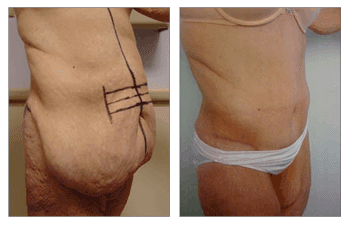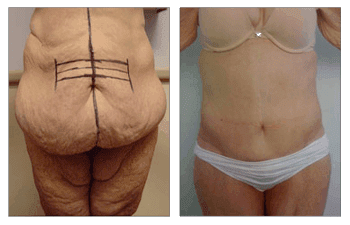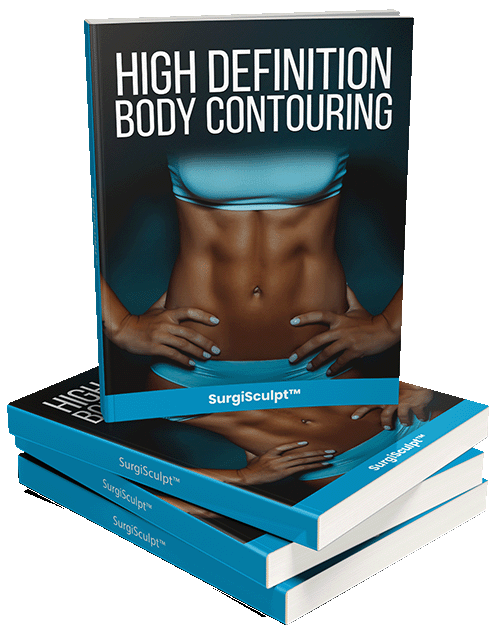


Introduction: Plastic Surgery after Gastric Bypass Surgery
As weight-loss surgeries such as gastric bypass and gastric sleeve increased in popularity (up 10% year over year since 2015), plastic surgeons have become inundated with requests for skin reduction surgery. Once patients have lost their weight, they desire their redundant skin removed to complete their body transformation.
When the skin is stretched past a certain point, it will not retain its original elastic ability after losing weight. Imagine an inflated balloon, once the air is completely deflated, there will be residual laxity that is caused by blowing it up all the way. This is where plastic surgery after gastric bypass surgery comes into play.
It has become so popular that many patients looking at gastric bypass surgery consult with a plastic surgeon before their weight loss surgery has been completed. These proactive patients want to get an idea of the outcome that they are striving for. So, what does plastic surgery after gastric bypass look like?
As you may have guessed, a patient looking for high definition body contouring after significant weight loss will score quite low on the High Definition Liposuction Body Scale. When picking a surgeon for your body contouring procedure, you are encouraged to consider a high definition body contouring surgeon like our SurgiSculpt surgeons.
He will utilize our high definition liposuction (HDL) body scale and protocols at your consultation. This scale ensures that the ideal procedure is used to reduce excess skin and contour your body after your gastric bypass surgery. For example, our patient at SurgiSculpt scored a 2 on the HDL body scale in her abdomen, then a staged full tummy tuck will be recommended first to bring her up to a 7.
Once she has healed from the elimination of severe skin redundancy, she will still require the elimination of excess fat which can be accomplished with ultrasound-assisted liposuction to bring her up to a near-perfect score of 9 or 10.
Plastic Surgery after Massive Weight Loss
After significant weight loss, whether through bariatric surgery or diet and exercise, many patients are left with excess skin and fatty tissue that can be a major source of discomfort and hindrance to their new lifestyle. There are various body-contouring procedures available to address these issues, including arm lift, thigh lift, tummy tuck, and full body lift. These procedures aim to remove excess skin and tissue, contour the body, and create a more aesthetically pleasing appearance.
The latest findings in post-weight loss plastic surgery have led to improved surgical techniques, such as utilizing minimally invasive procedures and incorporating advanced technologies like laser-assisted liposuction and radiofrequency skin tightening. These techniques can help to minimize scarring, reduce recovery time, and achieve better overall results.
Surgeons also consider the individual needs and goals of the patient when determining the most appropriate body-contouring procedures. In some cases, a combination of procedures may be recommended to achieve the desired outcome. Patients need to consult with a board-certified plastic surgeon who specializes in post-weight loss surgery to determine the best approach for their unique situation.
Introduction
Bariatric surgery can lead to several potential long-term side effects and complications. Nutrient deficiencies are common, as the body may struggle to absorb essential vitamins and minerals after surgery. Gastroesophageal reflux, or severe heartburn, can also occur due to changes in the stomach and digestive system. Redundant skin is another issue, as rapid weight loss can leave loose, sagging skin on the body.
Regular monitoring of nutrient levels is crucial for patients who have undergone bariatric surgery, as deficiencies can lead to serious health problems. Body contouring operations are often necessary to remove excess skin and improve the patient’s physical appearance and comfort.
These complications can have a significant impact on both physical and psychosocial health. Nutrient deficiencies can lead to fatigue, weakness, and other health issues, while excess skin may cause discomfort and self-esteem issues. Therefore, it is important for individuals who have undergone bariatric surgery to be aware of these potential complications and to seek appropriate medical care and support.
Procedures Offered following Bariatric Surgery per Area
Bariatric surgery is a life-changing procedure that helps individuals achieve significant weight loss and improve their overall health. After undergoing this surgery, patients may require additional medical procedures to help manage the physical and emotional changes that come with rapid weight loss. In this section, we will explore the various procedures offered to bariatric surgery patients in different areas, including dietary counseling, physical therapy, psychological support, and plastic surgery. These services aim to provide comprehensive care and support to patients as they navigate through their weight loss journey and adjust to their new lifestyle. From nutritional guidance to body contouring, bariatric surgery patients can access a range of resources to help them achieve long-term success and improved quality of life.
Abdomen
Abdominoplasty, commonly known as a tummy tuck, is a surgical procedure that is often performed on patients who have undergone significant weight loss surgery to remove excess skin and fat from the abdomen. The procedure involves making an incision along the lower abdomen, tightening the underlying muscles, removing excess skin and fat, and repositioning the remaining skin to create a more toned and smooth abdominal profile.
Potential complications of abdominoplasty in weight loss surgery patients include wound dehiscence (the separation of the surgical incision), fat necrosis (the death of fat tissue), and skin necrosis (the death of skin tissue). However, when performed by a skilled surgeon, the surgery can lead to improved body contours and enhanced self-esteem, which can significantly improve the patient’s quality of life and satisfaction with their appearance.
Post-operative outcomes of abdominoplasty typically include a flatter, more toned abdomen and a more defined waistline. Patients may experience some discomfort, swelling, and bruising in the days and weeks following the surgery, but these typically subside as the patient heals.
In conclusion, while abdominoplasty can lead to positive post-operative outcomes for weight loss surgery patients, it is important for patients to be aware of the potential complications associated with the procedure. Consulting with a qualified plastic surgeon and following post-operative care instructions can help minimize the risks and achieve the desired results.
Brachioplasty
Brachioplasty, also known as arm lift surgery, is a cosmetic procedure designed to remove excess skin and fat from the upper arms, resulting in a more toned and defined appearance. This surgery can also reshape the armpits, creating a smoother and more contoured silhouette. While brachioplasty provides many aesthetic benefits, it is important to note that it may result in visible scarring, particularly along the inner arm area.
During the procedure, the surgeon will typically make incisions on the inside or back of the arms to remove excess skin and fat. After the removal, the remaining skin is then carefully repositioned and secured with internal sutures to create a slimmer and more defined arm appearance. Post-surgery, patients are advised to wear compression sleeves to minimize swelling and aid in the healing process. The recovery period for brachioplasty may involve some discomfort and restricted arm movement, but most patients are able to return to their normal activities within a few weeks.
Brachioplasty can provide significant benefits for individuals seeking to address excess skin and fat on their upper arms, but it is important to carefully consider the potential for scarring and the recovery process before undergoing the procedure.
Thighs
Thigh aesthetics can be addressed through various surgical procedures, including thighplasty, thigh lift, and thigh reduction.
Thighplasty, also known as a thigh lift, involves removing excess skin and fat from the thighs to create a more toned and sculpted appearance. This procedure is suitable for individuals who have lost a significant amount of weight or have excess skin due to aging. Thigh reduction, on the other hand, focuses on reducing the overall size of the thighs by removing excess fat through liposuction or surgical excision.
The potential benefits of these procedures include improved thigh contour, increased self-esteem, and enhanced body proportion. However, these surgeries also come with potential risks such as scarring, infection, and dissatisfaction with the results. It’s important for patients to have realistic expectations and undergo thorough pre-surgery evaluations to ensure they are suitable candidates for these procedures.
Key considerations for a successful thigh surgery include being in good mental, physical, and emotional health, as well as maintaining realistic expectations about the outcomes. Patients should also choose a qualified and experienced surgeon and closely follow post-operative instructions to optimize their results.
Face and Neck
Facial rejuvenation in MWL (massive weight loss) patients presents unique challenges due to the significant deflation in the face and ptotic (drooping) eyebrow. The goal of treatment is to remove excess skin, restore anatomic structures, and augment subcutaneous tissue. This is typically achieved through face and neck lifting procedures, which can address the deflated appearance of the face and the sagging of the neck. Additionally, brow lifting can help elevate the ptotic eyebrow and improve the overall aesthetic of the upper face. In some cases, temporary fillers or permanent fat injections may be used to further augment the subcutaneous tissue and provide more youthful contours to the face. These interventions aim to restore volume and improve the overall harmony and balance of the facial features in MWL patients. By addressing the specific concerns of excess skin and subcutaneous tissue deflation, facial rejuvenation procedures can greatly enhance the appearance and confidence of MWL patients.
Upper Back
The procedures involved in an upper body lift, specifically targeting the upper back, may include removing excess skin and fat, lifting and tightening the skin and underlying tissue, and improving the overall contour of the back. Incisions may be made across the mid-back to access and address excess skin and tissue.
MWL from an upper body lift may require wearing a light compression vest to support the healing tissues and reduce swelling. It is also important to elevate the arms to further minimize swelling.
When performing an upper body lift, it is crucial to minimize the visibility of incisions by placing them in natural body creases and less visible areas. This helps to ensure that the scars are less noticeable and blend seamlessly with the body’s natural contours.
Overall, an upper body lift is a comprehensive procedure that may involve incisions across the mid-back, and recovery involves wearing a light compression vest and elevating the arms to reduce swelling. It is important to prioritize minimizing the visibility of incisions to achieve the best aesthetic outcome.
Lower Back and Flanks
Lower back and flank pain can be caused by a variety of conditions, including muscle strain, kidney stones, and sciatica. Muscle strain is a common cause of lower back pain, often resulting from overexertion or improper lifting. Kidney stones can cause intense pain in the lower back and flanks as they pass through the urinary tract. Sciatica, which is caused by compression or irritation of the sciatic nerve, can also result in radiating pain from the lower back down to the legs.
Symptoms associated with lower back and flank pain may include stiffness, muscle spasms, and urinary changes. Stiffness in the lower back may occur after periods of inactivity or as a result of muscle strain. Muscle spasms can cause sharp, shooting pain in the lower back and flanks. Urinary changes, such as increased frequency, urgency, or the presence of blood in the urine, may be indicative of kidney stones or other kidney-related issues.
It is important to consult a healthcare professional if you experience persistent or severe lower back and flank pain, as well as any associated symptoms, for proper diagnosis and treatment.
Buttocks
A buttock lift, also known as gluteoplasty, is a surgical procedure designed to improve the shape and appearance of the buttocks. It involves removing excess skin and fat, and lifting the remaining tissue to create a firmer and more toned appearance. The benefits of a buttock lift include enhancing the contours of the buttocks, improving overall body proportions, and boosting self-confidence.
For some patients, a buttock lift can be combined with liposuction to remove excess fat deposits, or with a buttock augmentation using implants or fat grafting to achieve a more voluminous look. It is important for individuals considering a buttock lift to be in good health and have realistic expectations about the results.
Patients have the option to customize their buttock lift procedure based on their specific needs and desires. Maintaining a healthy lifestyle post-surgery is crucial to maintain the results and ensure optimal healing.
Key factors to consider before pursuing a buttock lift include excess fat deposits, loose skin, and weak muscles in the buttock area. Patients can expect to achieve a firmer, tighter appearance of the buttocks after the procedure.
Conclusion: Plastic Surgery after Gastric Bypass
Plastic surgery after gastric bypass surgery can put the finishing touch on your amazing body transformation. Contact SurgiSculpt for a complimentary body contouring consultation today.
After gastric bypass surgery female of 56-year-old female 3 months following abdominoplasty with muscle plication to correct severe skin redundancy.
